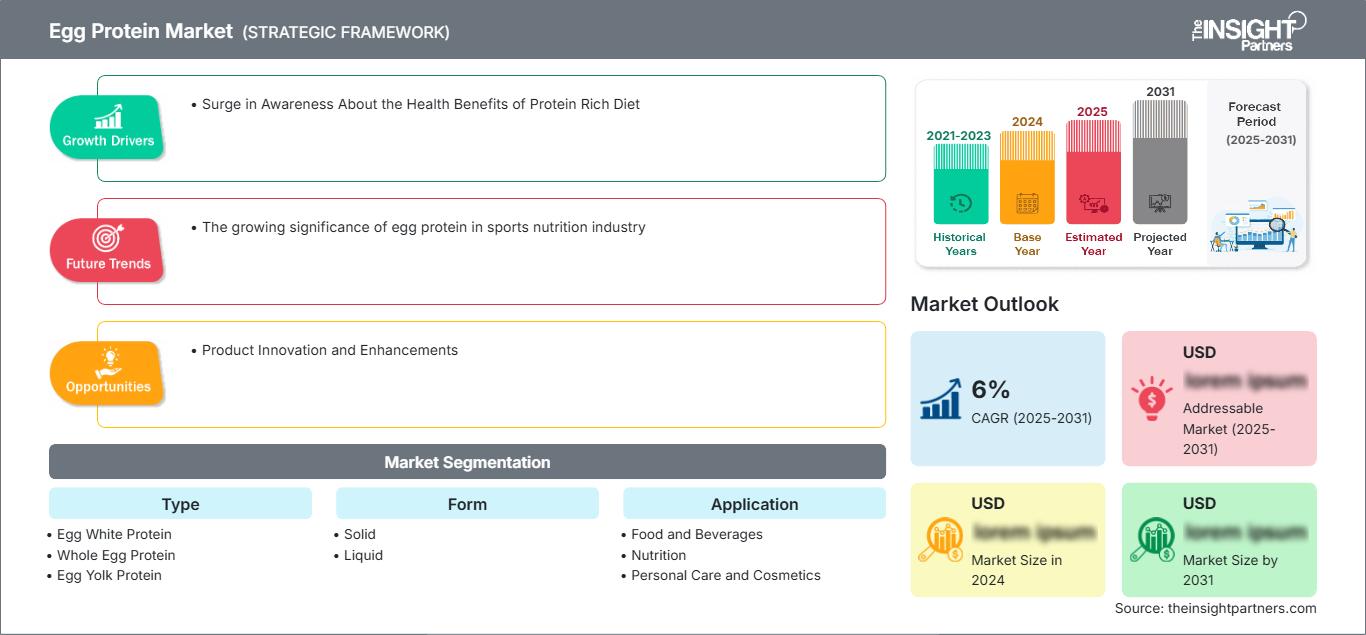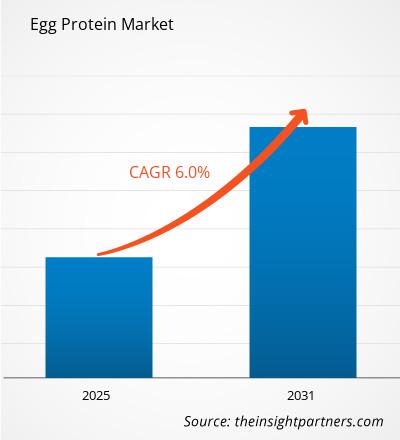Der Markt für Eiproteine wird zwischen 2023 und 2031 voraussichtlich eine durchschnittliche jährliche Wachstumsrate (CAGR) von 6 % verzeichnen. Die wachsende Bedeutung von Eiprotein in der Sporternährungsbranche dürfte ein wichtiger Markttrend bleiben.
Eiprotein-Marktanalyse:
- Die zunehmende Verbreitung von Krankheiten wie Fettleibigkeit macht die Bevölkerung besorgter und sensibilisiert sie für die Notwendigkeit, ein gewisses Maß an Gesundheit zu erhalten.
- Dieses steigende Gesundheitsbewusstsein der Verbraucher treibt die Nachfrage nach gesünderen Ernährungsgewohnheiten und die Teilnahme an Fitnessaktivitäten jeglicher Art voran.
- Daher zielt der Markt für Eiprotein aufgrund seiner ernährungsphysiologischen und biooxidativen Eigenschaften darauf ab, den Bedarf an hohem Proteingehalt in einer ausgewogenen täglichen Ernährung zu decken und so den Gesamtbedarf gesundheitsbewusster, fitnessbegeisterter Verbraucher zu decken.
- Dieses Produkt wird auch im Körperpflegesegment verwendet und findet aufgrund der enthaltenen Phospholipide auch in der Kosmetikindustrie als Emulgator und hautregenerierendes Mittel Verwendung.
- Das wachsende Bewusstsein für das Potenzial von Eiprotein als funktionelles, biologisch abbaubares und biokompatibles Element wird die Nutzung des Produkts weiter ankurbeln und den Markt in den kommenden Jahren weiter vorantreiben.
Marktübersicht für Eiprotein
- Eiproteine gelten als multifunktionale Zutaten, die effektiv in der Zubereitung verschiedener Lebensmittel verwendet werden.
- Diese Lebensmittel werden aufgrund ihrer Nährwerte und Bioaktivität häufig in der Lebensmittelverarbeitung verwendet.
- Abgesehen davon wird Eiprotein als Emulgator, Schaumbildner, Verdickungs- und Geliermittel verwendet, was seine Anwendung in der Lebensmittel- und Getränkeindustrie erhöht.
- Eiproteinzutaten werden umfassend in der Nahrungsmittel-, Tierfutter- und Kosmetikindustrie verwendet.
Passen Sie diesen Bericht Ihren Anforderungen an
Sie erhalten kostenlos Anpassungen an jedem Bericht, einschließlich Teilen dieses Berichts oder einer Analyse auf Länderebene, eines Excel-Datenpakets sowie tolle Angebote und Rabatte für Start-ups und Universitäten.
Markt für Eiproteine: Strategische Einblicke

- Holen Sie sich die wichtigsten Markttrends aus diesem Bericht.Dieses KOSTENLOSE Beispiel umfasst Datenanalysen, die von Markttrends bis hin zu Schätzungen und Prognosen reichen.
Treiber und Chancen des Eiproteinmarktes Steigendes Bewusstsein für die gesundheitlichen Vorteile einer proteinreichen Ernährung
Sie erhalten kostenlos Anpassungen an jedem Bericht, einschließlich Teilen dieses Berichts oder einer Analyse auf Länderebene, eines Excel-Datenpakets sowie tolle Angebote und Rabatte für Start-ups und Universitäten.
Markt für Eiproteine: Strategische Einblicke

- Holen Sie sich die wichtigsten Markttrends aus diesem Bericht.Dieses KOSTENLOSE Beispiel umfasst Datenanalysen, die von Markttrends bis hin zu Schätzungen und Prognosen reichen.
- Das steigende Bewusstsein für die gesundheitlichen Vorteile einer proteinreichen Ernährung treibt den Eiproteinmarkt an.
- Die Menschen achten zunehmend auf ihre Gesundheit und suchen nach Möglichkeiten, ihr Wohlbefinden zu verbessern.
- Proteinreiche Lebensmittel sind bei Menschen beliebt geworden, die Muskeln aufbauen und Gewicht verlieren möchten.
- Das Ei wird als vollwertiges Protein identifiziert, das alle essentiellen Aminosäuren enthält. Diese Aminosäuren werden vom Körper benötigt, damit Muskeln wachsen, repariert und sogar erhalten werden können.
- Das zunehmende Verständnis der Rolle von Proteinen bei der Gewichtskontrolle, beim Bodybuilding und beim Sättigungsgefühl hat eine unersättliche Nachfrage nach Proteinen auf Eibasis auf dem Markt geschaffen.
- Daher hat sich der Markt für Eiproteine erheblich erweitert und umfasst nun verschiedene Produktformate, Pulver, flüssiges Eiweiß und angereicherte Lebensmittel.
Produktinnovation und -verbesserungen
- Der Markt bietet in Zukunft Möglichkeiten zur Innovation und Verbesserung von Eiproteinprodukten.
- Verbraucher auf der ganzen Welt suchen zunehmend nach nachhaltigeren Quellen für gesündere Proteine.
- Hersteller könnten diese Markttrends zu ihrem Vorteil nutzen und neuartige Eiproteinformulierungen entwickeln, die für eine breite Palette von Ernährungsanforderungen und -präferenzen geeignet sind, wie beispielsweise proteinreiche Lebensmittelprodukte für Sportler; Formulierung von Produkten auf Eiproteinbasis, die frei von üblichen Allergenen sind, und Vermarktung von verzehrfertigen Produkten, die mit Eiproteinen angereichert sind.
- Ein Beispiel für Ersteres ist das Eier-Snack-Sortiment unter der Marke „Fast – Egg Mayonnaise Drinks“. Marke der Beijing Daily Heart Health Food Co. in China.
- Durch die Verfeinerung bestehender Produkte oder die Einführung neuartiger Eiproteinprodukte könnten Unternehmen daher neue Marktdifferenzierungen schaffen, gesundheitsbewusste Verbraucher ansprechen und Anwendungsbereiche in ungenutzten Verbraucheroptionen erschließen, die bisher keine eibasierten Lebensmittel in Betracht gezogen haben, wodurch der gesamte Markt für Eiproteinprodukte erweitert würde.
Segmentierungsanalyse des Eiproteinmarktberichts
Der Umfang des globalen Eiproteinmarktes ist nach Art, Form und Anwendung segmentiert.
- Basierend auf der Art ist der Eiproteinmarkt in Eiweißprotein, Volleiprotein und Eigelbprotein segmentiert.
- In Bezug auf die Form ist der Markt in fest und flüssig unterteilt.
- Basierend auf der Anwendung ist der Markt in Lebensmittel und Getränke, Ernährung, Körperpflege und Kosmetik, Futtermittel und Sonstiges unterteilt.
Marktanteilsanalyse für Eiprotein von Geographie
- Der Bericht zum Markt für Eiproteine enthält eine detaillierte Analyse von fünf großen geografischen Regionen, einschließlich der aktuellen und historischen Marktgröße sowie Prognosen für 2021 bis 2031. Er deckt Nordamerika, Europa, den asiatisch-pazifischen Raum (APAC), den Nahen Osten und Afrika (MEA) sowie Süd- und Mittelamerika ab.
- Jede Region ist weiter in entsprechende Länder unterteilt. Dieser Bericht bietet Analysen und Prognosen für mehr als 18 Länder und deckt die Marktdynamik von Eiproteinen ab, wie z. B. Treiber, Trends und Chancen, die die Märkte auf regionaler Ebene beeinflussen.
- Darüber hinaus umfasst der Bericht Porters Fünf-Kräfte-Analyse, die die Untersuchung der wichtigsten Faktoren umfasst, die den Eiproteinmarkt in diesen Regionen beeinflussen.
Eiweißmarkt
Die Analysten von The Insight Partners haben die regionalen Trends und Faktoren, die den Eiproteinmarkt im Prognosezeitraum beeinflussen, ausführlich erläutert. In diesem Abschnitt werden auch die Marktsegmente und die geografische Lage in Nordamerika, Europa, dem asiatisch-pazifischen Raum, dem Nahen Osten und Afrika sowie Süd- und Mittelamerika erörtert.Umfang des Marktberichts zu Eiprotein
| Berichtsattribut | Einzelheiten |
|---|---|
| Marktgröße in 2024 | US$ XX million |
| Marktgröße nach 2031 | US$ XX Million |
| Globale CAGR (2025 - 2031) | 6% |
| Historische Daten | 2021-2023 |
| Prognosezeitraum | 2025-2031 |
| Abgedeckte Segmente |
By Typ
|
| Abgedeckte Regionen und Länder | Nordamerika
|
| Marktführer und wichtige Unternehmensprofile |
|
Dichte der Marktteilnehmer für Eiproteine: Verständnis ihrer Auswirkungen auf die Geschäftsdynamik
Der Markt für Eiprotein wächst rasant, angetrieben durch die steigende Endverbrauchernachfrage aufgrund von Faktoren wie sich verändernden Verbraucherpräferenzen, technologischem Fortschritt und einem stärkeren Bewusstsein für die Produktvorteile. Mit steigender Nachfrage erweitern Unternehmen ihr Angebot, entwickeln Innovationen, um den Verbraucherbedürfnissen gerecht zu werden, und nutzen neue Trends, was das Marktwachstum weiter ankurbelt.

- Holen Sie sich die Markt für Eiproteine Übersicht der wichtigsten Akteure
Der Markt für Eiprotein wird durch die Erhebung qualitativer und quantitativer Daten aus Primär- und Sekundärforschung bewertet, die wichtige Unternehmenspublikationen, Verbandsdaten und Datenbanken umfasst. Im Folgenden finden Sie eine Liste der Entwicklungen auf dem Markt für Innovationen, Geschäftserweiterungen und Strategien:
- Onego Bio Poaches hat in Nordamerika ein präzisionsfermentiertes Eiprotein der Serie A im Wert von 40 Millionen US-Dollar auf den Markt gebracht, das über 20 funktionelle Vorteile von der Belüftung bis zur Emulgierung und Gelierung bietet. (Quelle: Onego Bio, Newsletter, April 2024)
- Die EVERY Company, ein Pionier der Präzisionsfermentationstechnologie für Eiproteine, gründete multinationale Lebensmittelunternehmen, um die Produktionskapazität für tierfreie Eiproteine zu erhöhen, mit dem Ziel, die Nachfrage zu decken und die Produktionskapazität zu erweitern. (Quelle: The EVERY Company, Newsletter, Februar 2024)
Bericht zum Markt für Eiprotein: Umfang und Ergebnisse
Der „Marktbericht für Eiprotein: Größe und Prognose (2021 – 2031)“ bietet eine detaillierte Analyse des Marktes in den folgenden Bereichen:
- Marktgröße und Prognose für Eiprotein auf globaler, regionaler und Länderebene für alle abgedeckten wichtigen Marktsegmente
- Markttrends und Marktdynamiken für Eiprotein wie Treiber, Einschränkungen und wichtige Chancen
- Detaillierte PEST/Porters Fünf-Kräfte- und SWOT-Analyse
- Marktanalyse für Eiprotein mit wichtigen Markttrends, globalen und regionalen Rahmenbedingungen, wichtigen Akteuren, Vorschriften und aktuellen Marktentwicklungen
- Branchenlandschaft und Wettbewerbsanalyse mit Marktkonzentration, Heatmap-Analyse, prominenten Akteuren und aktuellen Entwicklungen für den Eiproteinmarkt
- Detaillierte Unternehmensprofile
- Historische Analyse (2 Jahre), Basisjahr, Prognose (7 Jahre) mit CAGR
- PEST- und SWOT-Analyse
- Marktgröße Wert/Volumen – Global, Regional, Land
- Branchen- und Wettbewerbslandschaft
- Excel-Datensatz
Aktuelle Berichte
Verwandte Berichte
Erfahrungsberichte
Grund zum Kauf
- Fundierte Entscheidungsfindung
- Marktdynamik verstehen
- Wettbewerbsanalyse
- Kundeneinblicke
- Marktprognosen
- Risikominimierung
- Strategische Planung
- Investitionsbegründung
- Identifizierung neuer Märkte
- Verbesserung von Marketingstrategien
- Steigerung der Betriebseffizienz
- Anpassung an regulatorische Trends




















 Kostenlose Probe anfordern für - Markt für Eiproteine
Kostenlose Probe anfordern für - Markt für Eiproteine